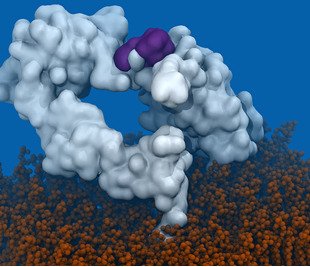
Research Description
How can a single mutation disrupt protein function and propagate throughout scales, from cells to tissues and the whole organism causing diseases like cancer? How can the change of just a few atoms in an oncogene trigger the formation of a tumor? How is the sequence of a protein related to its shape and function?
We aim to answer these fundamental questions by exploring the molecular basis of mendelian diseases and cancer at the deepest level, in terms of protein structures and their motions at the atomic scale. In the same way as animal shapes are selected by evolution to fly, run or swim, each protein fold has been evolutionarily selected to perform certain motions, the so-called “conformational-changes”, which dictate biological function. In cancer cells, proteins also mutate and quickly evolve their “phenotypes” - their conformational dynamics and resulting cellular function - in order to adapt to their environment and promote oncogenic growth.
To reveal the key dynamic information contained in cancer mutation patterns, we develop simulation methods (Front.Mol.Biosciences, 2019; Nat.Comms, 2016) and servers (Bioinformatics, 2019) and integrate them with structural determination techniques (SAXS, cryoEM), in vitro and in vivo experiments. Using this interdisciplinary approach, we discovered that EGFR mutations in brain tumors converge to acquire a similar conformation, which is antagonistic from mutations in lung cancer and respond to different drugs. Our mechanistic insights set a rational basis for synergistic drug combinations that trap this glioblastoma-specific EGFR conformation, triggering tumor regression in animal tumor models (PNAS, 2019; Cancer Cell, 2018).
Our goal is to go beyond conventional oncogenes like EGFR and perform a complete conformational profiling of tumors, which will be essential to identify, group and rationally target evolutionarily selected mutations with conformation-specific drugs. We are also interested in mendelian disease mutational patterns, which can reveal essential aspects of protein function and we have shown unexpectedly overlap with mutations found in human tumors (Front.Mol.Biosciences, 2022).
On a broader view, we believe that understanding biomolecular dynamics, protein-protein interactions and folding, and their perturbations in human diseases is essential to connect the structural scale with higher-level observations in molecular biology and medicine and push the boundaries of biophysical research and our understanding of life mechanisms. Apart of deriving testable predictions from simulations, we have experience helping to rationalize experimental data at the structure/ dynamics- level (Nat.Comms., 2021; EMBO Journal; Nature, 2020; Cancer Cell, 2019) and are always interested to hear about potential collaborations.
Available positions
We are an inter-disciplinary group at the crossroads of computational biophysics & structural biology to generate new insights on protein function and malfunction to be tested in vitro and in vivo. If you are interested to join or just curious to know more about our research, please contact Laura Orellana
Projects and Research Lines
We develop algorithms to predict protein conformational changes and the impact of mutations on them, focusing specially on cancer:

1) Computational multiscale methods to study protein conformational changes:
- Coarse-grained & atomistic simulation methods: Normal Mode Analysis, Elastic Networks, Langevin Dynamics, classical Molecular Dynamics, Principal Component & Network Analysis of structural ensembles, machine learning, sampling algorithms.
- In silico mutational screening: Development of algorithms and tools to identify “dynamically hot” mutations shifting protein conformation.
2) Protein evolution, cancer mutations and conformational dynamics:
- Rationalization of mutational patterns for known oncogenes: conformational convergence in Tyrosine Kinase Receptors (EGFR)
- Discovery of new cancer drivers & biomarkers including house-keeping and tissue-specific proteins
Servers: eBDIMS server
